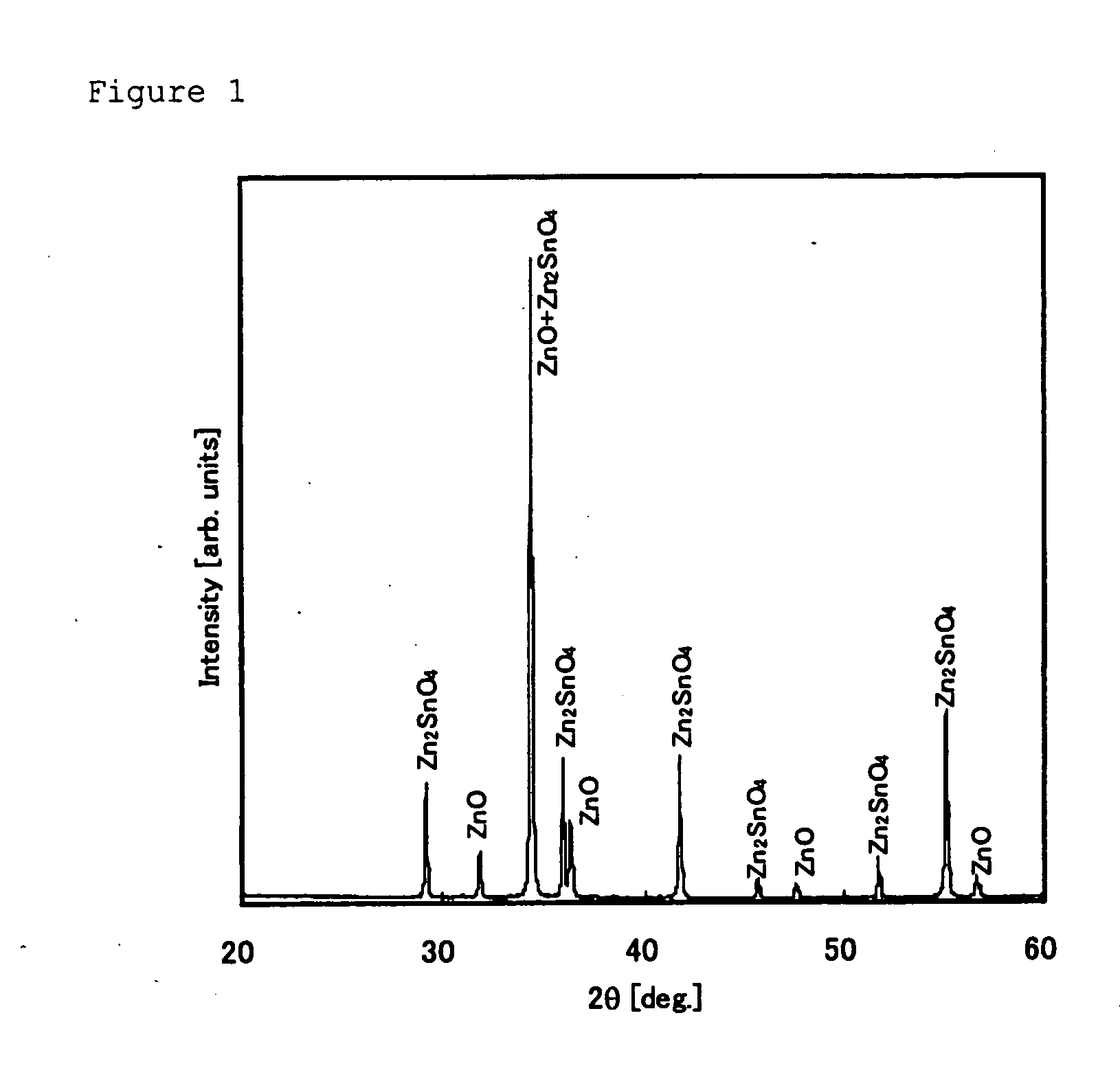Oxide sintered body, manufacturing method therefor, manufacturing method for transparent conductive film using the same, and resultant transparent conductive film
a manufacturing method and technology of oxidized sintered body, which are applied in the direction of conductive materials, diaphragms, metallic material coating processes, etc., can solve the problems of difficult to manufacture transparent conductive films, non-indium-based materials, and difficulty in maintaining small variation of oxygen gas amount in atmosphere gas, etc., to achieve excellent chemical resistance, high productivity, and stable characteristics
- Summary
- Abstract
- Description
- Claims
- Application Information
AI Technical Summary
Benefits of technology
Problems solved by technology
Method used
Image
Examples
examples
[0087] The present invention will specifically be explained below with reference to Examples, however, the present invention should not be limited thereto. In addition, the resultant oxide sintered body and transparent conductive film were evaluated by the following methods:
(Evaluation of the Oxide Sintered Body)
[0088] Resistivity of the resultant oxide sintered body was measured on the polished surface by a four-pin probe method.
[0089] On the other hand, generated phases were identified by powder X-ray diffraction measurement of the resultant oxide sintered body; diffraction peaks originating from a tin oxide phase of a rutile structure, a zinc stannate phase, ZnSnO3, described by the JCPDS card, 52-1381, and zinc oxide were observed. In addition, by local composition analysis by EPMA, whether or not tin was dissolved, as a sold solution, in a zinc oxide crystal phase was determined. Further, composition of the oxide sintered body was analyzed using an ICP emission spectroscopy...
examples 1 to 7
Manufacturing of the Oxide Sintered Body
[0091] Firstly, ZnO powder with an average grain size of equal to or smaller than 1 μm, and SnO2 powder with an average grain size of equal to or smaller than 1 μm were used as raw material powder, formulated at an atomic number ratio, Sn / (Zn+Sn), of 0.25, charged into a resin pot together with water, and mixed by a wet process ball mill. In this case, a hard ball made of ZrO2 was used, and mixing time was set to 18 hours. After mixing, slurry was taken out and subjected to filtering, drying and granulation.
[0092] The granule was subjected to compacting by pressurization under a pressure of 3 tons / cm2 by a cold hydrostatic press.
[0093] Then, the resultant compact was sintered under atmosphere introduced with oxygen into the atmosphere of the sintering furnace at a speed of 5 L / min. per 0.1 m3 of inner furnace volume (oxygen concentration of the calcination atmosphere to be 55%) at a temperature of 1450° C. for 20 hours. In this case, the t...
example 8
[0100] The oxide sintered body was prepared in the same way as in Example 1, except that the atomic number ratio, Sn / (Zn+Sn), was changed to 0.23, and the oxygen amount in the calcination atmosphere was changed to 40%. End parts of the resultant oxide sintered body was subjected to powder X-ray diffraction measurement; as for the oxide sintered body having a atomic number ratio, Sn / (Zn+Sn), of 0.23, diffraction peaks originating from the zinc oxide crystal phase of a wurtzite type structure, and the zinc stannate phase, Zn2SnO4, described by the JCPDS card, No. 24-1470 were observed; however, a diffraction peak originating from tin oxide such as SnO2 or SnO or the like was not observed. Local composition analysis of this sintered body by EPMA showed that tin was dissolved, as a sold solution, in the zinc oxide phase. Composition analysis of the resultant oxide sintered body, by ICP emission spectroscopy, showed that the composition was the same as that in raw material powder in form...
PUM
| Property | Measurement | Unit |
|---|---|---|
| atomic number ratio | aaaaa | aaaaa |
| atomic number ratio | aaaaa | aaaaa |
| resistivity | aaaaa | aaaaa |
Abstract
Description
Claims
Application Information
 Login to View More
Login to View More - R&D
- Intellectual Property
- Life Sciences
- Materials
- Tech Scout
- Unparalleled Data Quality
- Higher Quality Content
- 60% Fewer Hallucinations
Browse by: Latest US Patents, China's latest patents, Technical Efficacy Thesaurus, Application Domain, Technology Topic, Popular Technical Reports.
© 2025 PatSnap. All rights reserved.Legal|Privacy policy|Modern Slavery Act Transparency Statement|Sitemap|About US| Contact US: help@patsnap.com

